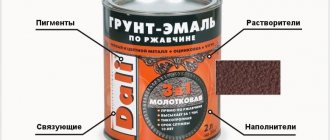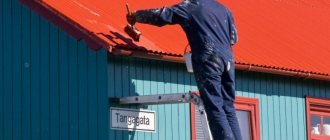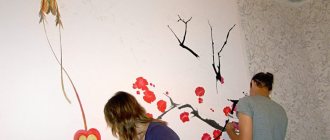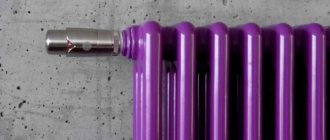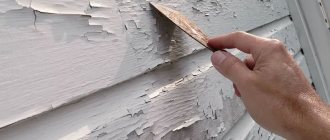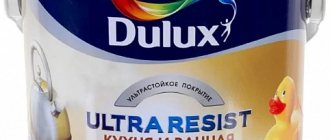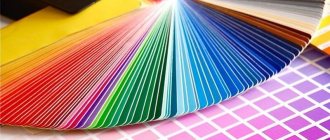Requirements for coloring compositions
Not every paint is suitable for a smooth finish. It must have maximum adhesion, that is, ideally adhere to the surface. Since galvanizing, although to a lesser extent, is also susceptible to corrosion (as evidenced by the appearance of whitish spots on it), it is desirable that the paint contains anti-corrosion components.
Traditional alkyd compositions based on resins that can react with zinc, as well as oil paints, are not suitable for these purposes. They contain not only acids and alkalis, but also some additives that can destroy the galvanized surface. Therefore, paint and varnish materials used for painting must be neutral to zinc.
Paint on galvanized metal intended for exterior use must be frost- and chemical-resistant and resistant to UV rays. Particular attention must be paid to its elasticity - after all, zinc changes dimensions when the temperature changes. Regular paint will crack and peel during use. Naturally, the color should also be selected so that it matches the exterior of the other buildings.
Selection of composition for coloring
If you don’t know how to paint galvanized steel to prevent it from peeling, use powder compositions containing fine particles and special resins. During the polymerization process, they form a durable coating that adheres well even to smooth surfaces, has good resistance to UV radiation and seasonal temperature changes, and has chemical resistance, impact resistance and elasticity. Such paints and varnishes do not require dilution, as they are sold already in solution. To protect the metal, multiple coatings are not required—a layer 60 microns thick is sufficient.
In addition to powder suspensions, you can use some types of enamel, primers, compositions containing polyester and plastisol, for example:
- “Tsikrol”: roofing primer-enamel, intended specifically for painting galvanized sheets, the composition includes acrylic resins, the solvents are organic compounds such as solvent, ethyl acetate, xylene, butyl acetate; easy to use, has good adhesion; average drying time 18 hours;
- “Serebrol” based on epoxy and perchlorovinyl elastic resins with the addition of aluminum powder that can reflect UV rays, protecting the roof and other structures from overheating; hardens at 20°C for 3 hours; color silver-white;
- “Nerzhalux” enamel based on acrylic copolymers: viscous, adheres well to the surface, wear-resistant, not exposed to acids and alkalis, and has low flammability; can last up to 10 years;
- alkyd enamels, which can also be used as paint for roofs or other structures made of galvanized metal; they adhere well even to smooth surfaces, have good elasticity, frost resistance, and almost do not fade in the sun; however, they cost a lot, so they are rarely used for outdoor work.
To process products used in harsh aggressive environments, special fire-resistant and electrically conductive paints and varnishes intended for application to metal surfaces are used.
Popular acrylic paints
The most popular among dyes for galvanized surfaces are acrylic products.
Among acrylic paints, the following product brands are distinguished:
- Cyclol. The dye does not require preliminary priming and is used for pipes and galvanized sheets. It is water and weather resistant, dries quickly and does not fade. Basic colors: gray, green, brown, burgundy and white. The advantage of paint is that it is applied in one layer. The disadvantage is high toxicity, so you need to work in a respirator.
- Nerzhalux. Used for treating surfaces made of galvanized steel, aluminum, stainless steel, copper, brass, lead, titanium. In favorable conditions, apply one coat of paint, without using a primer. If you use 1 layer of primer and 2 layers of enamel, the metal surface will receive reliable protection for 7 years, with a three-layer coating - up to 10 years.
- Serebrol. Aluminum powder is used as a base for the product. Special anti-corrosion additives are added to the composition. Silver scrap covers not only galvanized steel, but also ferrous metal. Self-use is possible. In combination with a primer, a protective barrier is created for up to 15 years. The product is capable of dissipating infrared radiation, which protects the surface from overheating. Serebrol, like Nerzhalux, is used for painting pipes operating in fresh or salt water.
- Primer enamel AK-125 OCM. This paint is applied without primer, in 2-3 layers. Can be used on any surface: roofs, gutters, gutters and other parts and structures. It dries quickly, has hydrophobic properties, and is not afraid of moisture even when not dried. Does not lose its characteristics from atmospheric influences. Has a rich color palette.
Note! Any galvanizing paint composition is intended for outdoor use. Therefore, when painting indoors, it is necessary to take safety measures for residents. The room is ventilated until the painted surface is completely dry.
Dyeing technology
Experts recommend painting galvanized steel a year after the start of use, when the oxidation products have completely disappeared and a durable patina film appears on the surface. Plus, during this time the coating will become slightly rough - the paint will stick much better. If painting is done immediately after purchase, it is advisable to pre-treat the surface of the sheets with abrasives.
- To protect against corrosion during storage, manufacturers coat metal sheets with a layer of mineral oil. It must be dissolved with ammonia water.
- The old layer of paint and traces of corrosion are cleaned off with fine abrasive sandpaper or a wire brush. Be careful not to damage the coating. For large volumes, sandblasting is used.
- The surface must be clean and dry. This is especially true for alkyd enamel. If it gets exposed to dust or moisture, it will begin to peel off after drying.
- To degrease and remove salt stains, the metal is washed with a soap or alkaline solution and then dried well.
- Before coating with paints and varnishes, it is recommended to treat the surface with a primer. This will not only save paint, but also enhance adhesion. It is selected according to a color similar to the color of the paint and varnish composition.
- If necessary, solvents are introduced into it. Their types are always indicated in the manufacturer's instructions.
- Apply the paint in a thin layer using special sprayers. Small areas can be treated with a brush or roller.
- When applying subsequent layers, the surface should be thoroughly dried.
So, we have described in detail how to paint galvanized steel so that it does not peel off. For these purposes, special compounds with high adhesion are used that are resistant to aggressive environments and temperature changes. The industry offers a sufficient selection of colors of such paint and varnish compositions that have a long service life, from which you can choose the appropriate ones.
Source: kraskaok.ru
Coloring stages
A wide range of paints and varnishes are used for painting metal pipes - all of them perform a decorative and protective function, reducing the risk of corrosion on the surface of the products. Alkyd, polyurethane paints, and water-dispersion enamels are widely used. Today they are being replaced by powder coating - polyester, epoxy and epoxy-polyester dyes, which are completely free of toxic and flammable solvents.
Powder coating technology is considered the most reliable, and the durability of the resulting coating is considered the most durable, since it does not lose its properties for up to 30-50 years, even when pipes are used in places with high humidity, in basements, underground and in the air.
Thanksgiving letters
Thank you letter Gypsum metal
Dear Alexey Albertovich! PZSPP LLC, represented by its manager Dmitry Aleksandrovich Maksimov, expresses sincere gratitude to the entire team of Diline Color LLC for the fruitful cooperation in the provision of services for painting products with powder paints. Diline Color LLC has been our partner for many years, and during our joint cooperation, it has proven itself to be a true professional in its field and demonstrated its ability to meet the highest requirements set by our company. We are pleased with the work of Diline Color LLC and are ready to recommend this company as a responsible and reliable partner.
Entek thank you letter
Dear Alexey Albertovich,
Entek LLC thanks you and your team for the fruitful cooperation. We wish you further prosperity, effective work, inexhaustible energy in achieving your goals and creative inspiration in solving global problems, as well as healthy competition and excellent health to maintain your working tone! Let us be slaves to the development of our cooperation and mutual understanding.
High-quality powder coating is possible only in industrial conditions, using special equipment. Stages of its implementation:
- the surface of the products is completely cleaned of dirt or traces of rust by sandblasting using quartz sand;
- then it is degreased, pickled and washed;
- primer is performed with compounds containing titanium and zinc - for better adhesion and additional protection against corrosion;
- powder is applied to the surface of the pipe from a spray gun or jet unit, which is firmly and tightly fixed due to the difference in the electrical charges of the paint and metal;
- in a special high-temperature chamber, the powder is heated and melted to produce a durable single-layer polymer film;
- the finished product cools down and acquires its presentation.
How to paint galvanized steel - how to choose and apply the composition correctly
Many people do not understand why paint zinc-coated steel, since it is already very reliable and durable. However, during use there is often a need for additional protection, and the aesthetic appearance of such a coating is not very attractive. Let's look at how to paint galvanized steel and how to do it in accordance with the technology.
In the photo: painting not only protects the surface, but also significantly improves the appearance
Main stages of work
So, when carrying out work with your own hands, you need to carry out all activities in a certain sequence. This will simplify the whole process, because you will know exactly what to do and why.
Paint selection
A very important stage, since not every composition is suitable for the job.
As a rule, in trading you can find the following options:
- Most often, special galvanized roofing paints are used. They are highly resistant to weathering and give the surface a water-repellent effect; most often the composition is based on acrylic resins. The packaging should specifically indicate that the composition is suitable for zinc coatings; you should not take the seller’s word for it, since it is unlikely that he himself painted such materials.
Roofing paints are sold in large containers
- If materials are exposed to aggressive influences, it is better to treat them with more durable compounds. These include alkyd-urethane coatings, which are very reliable, but their cost is also higher. Do not forget that the instructions on the package must be studied before use, this will avoid problems during operation.
Alkyd-urethane composition has high performance properties
- If you have galvanized structures that need to be additionally protected from fire in case of a fire, then you need fire-retardant metal paints Polistil; there are other manufacturers, but this product has a reasonable cost and has proven itself well among specialists. The difference between these compositions is their ability to bubble under the influence of fire and create a protective coating that increases the strength of the structure.
Polistil paint will greatly increase the fire resistance of structures
- Another option is Zinga conductive paint. This is a one-component composition that consists of 96% zinc, which gives it the highest anti-corrosion properties. This is a kind of analogue of factory hot-dip galvanizing, the work is quite simple, so you will not have any difficulties, the paint is expensive, so it should be used only where the highest degree of protection is required.
This composition is one of the most reliable, but its cost is appropriate
A very common question is: how to paint a galvanized pipe? Let us note right away that if it is heated to high temperatures, it is unlikely that any composition will be durable. But if the temperature is low or the pipes are part of the ventilation system, then they are painted with the same paints as sheet metal.
Remember! All galvanizing paints are intended for outdoor use. Therefore, if you are working inside, do not forget about the need to properly ventilate the room before the paint dries; evaporation of steel compounds is not always harmless.
Surface preparation
A very important stage, since without proper preparation the paint simply will not adhere and will peel off in a short time.
Everything is quite simple here:
- The best preparation is natural aging of the surface. It's very simple: galvanized steel is left for 1 year, exposed to temperature changes, humidity and other factors, causing the surface to become rougher, which improves adhesion. In addition, inhibitors that impair paint adhesion are washed off from the material.
- If a powdery coating (so-called white rust) has formed on the surface, it must be removed, but do not be too zealous so as not to damage it.
- It is best to carry out the treatment with any alkaline solution (even washing powder will do); it will remove dirt and stains from lubricants and other materials.
- The last stage is to wash off the solution with water, it is best to do this with a high-pressure apparatus - it will wash away both the dirt and the cleaning solution.
For work on the roof, it is better to choose a lightweight and compact washing option.
Painting works
Everything is quite simple here:
- If the paint does not contain primer, the surface is treated with a special primer. You can continue work only after it has dried.
- Painting is carried out from the ridge along the slope. Work can be carried out in different ways: with a brush, roller or spray gun (this method is the most economical).
Advice! To avoid slipping, you should walk on the roof in felt boots or shoes with felt heels; this will significantly increase safety when carrying out work.
The sprayer makes work quick and easy
When is it necessary to paint galvanized pipes?
One of the reasons for painting galvanized pipes is that under the influence of the sun, air, and water, a thin zinc film loses its qualities over time: it becomes thinner, and pinpoint damage appears. Then the protection becomes unreliable, and the steel quickly rusts.
In addition, the surrounding aggressive environment can damage the zinc itself over time: a white coating forms on it. In such cases, painting extends the service life of rolled metal.
Another reason why additional anti-corrosion protection is required is zinc peeling at welded joints.
It is recommended to paint water-gas pipes (WGP) when they are hot-dip galvanized, i.e. protection is applied on the outside and inside.
Note! If galvanization is present only on the outside, then there is no point in painting, because this is unlikely to extend the service life, since the inner surface of the pipe is still subject to corrosion.
There is no consensus on the need to paint galvanized pipes in an apartment. The homeowner makes the decision himself. If the metal structure disrupts the harmony in the design of the room, or the owner does not like the dull gray color of the pipes, he can paint them in any color.
Powder painting of galvanized metal
From NAYADA you can order powder painting of galvanized metal in Moscow. We accept corrugated sheeting, metal tiles, pipes and other types of galvanized sheeting up to 7 meters in length. Our production facilities include several painting lines, which allows us to quickly fulfill even large orders. Galvanization is painted only with high-quality powder paints from DuPont, AkzoNobel, Pulver, Primatek, Neokem and other well-known brands - such coatings last up to 30 years.
How is galvanized painting done?
Let's consider the sequence of applying polymer material to a galvanized surface. Powder coating of corrugated sheets includes the following steps:
- Preparation . One of the key stages, which subsequently determines the durability, aesthetics and anti-corrosion properties of the coating. To ensure reliable adhesion of paint to metal, all dirt, dust, and grease particles are first removed from it. For this purpose, a mechanical (cleaning with grinding discs, brushes, wiping with a cloth soaked in solvent) or chemical (application of acids and alkalis) method is used. To increase adhesion to the powder, the galvanized surface is coated with a layer of phosphates.
- Painting galvanized sheet . After rinsing and drying, the product is grounded and coated with electrostatically charged powder. The paint is supplied under pressure through the feeder holes. The suspension lies in an even layer on the metal surface. Due to the difference in charges of the product itself and the incoming powder, uniform painting of the corrugated sheet occurs - regardless of the shape of the product.
- Polymerization . In a special oven, the applied powder is fused under high temperature into a strong, uniform film that is resistant to temperature changes and mechanical damage. The cooled coating does not have the defects inherent in liquid paint: drips, craters, etc.
Recommendations for preparing for painting
The first stage of painting is preparatory work. Using sandpaper and solvents, the pipe is cleaned of rust, scale, oils, and old paint residues. Dirt and dust are washed off with detergents (or washing powder). This is necessary so that the new enamel coating does not peel off. It is also important to get rid of the grease that forms on the pipes in the kitchen.
We recommend that you read: Connecting pipelines made of polypropylene pipes
To remove fat and oil deposits, alkaline, acid, alcohol or water-based fat solvents and special emulsions (Chistomet-Ts, FAS-104, acetone half with toluene, etc.) are used. After washing, the surface is dried.
Note! After cleaning the surface with chemicals, it is washed with clean water, because residual salts and other active compounds reduce the protective properties of the enamel coating, and pockets of corrosion form under it.
The second stage of preparation is priming. The primer itself already performs protective functions. In addition, it ensures reliable adhesion of the paint to the metal surface. It is not recommended to use alkyd compounds for primers, because they have a negative effect on zinc. The following materials deserve attention: Rostex Super, Grit Metal, Special Metal Primer.
Pros of powder coating
Powder coating has the following advantages that liquid solvent-based materials do not have:
- Environmental friendliness . Powder paint contains no toxic compounds and has virtually no chemical odor. Volatile substances that are released during the polymerization process do not exceed the maximum permissible concentration. If the list of requirements for your production includes compliance with environmental standards, this technology is optimal. Powder painting technology is environmentally friendly.
- Durability and impact resistance . The material does not require viscosity control or tinting and is supplied ready-made. Due to its porosity, the coating is wear-resistant, has anti-corrosion properties, and easily withstands environmental influences, including precipitation and temperature changes (in the range from -60 to +150 degrees). In addition, painting a galvanized sheet provides electrical insulation of the coating.
- Economical . Technology minimizes waste. When galvanized corrugated sheeting is painted, the substance is almost completely (about 95%) transferred to the working surface. But even if there is excess material left, it can be reused. Due to the fact that there are no solvents in the composition, there is no need to waste time and money on special weathering after applying the paint.
In addition, powder coating of corrugated sheets makes the coating more aesthetically pleasing. Unlike coating with a liquid compound, the powder layer will be uniform, without streaks, bubbles, or peeling fragments, which means the product will retain its original attractive appearance longer.
Paint for galvanized pipes: what to paint (types), is it necessary, how to paint galvanized pipes correctly
Welcome to our website! From the materials of the article, the reader will learn why paint is needed for galvanized pipes. Choosing the right paint from the variety available on the market is not easy for a beginner. Let's take a closer look at what you should pay attention to, how to calculate the required quantity and paint the pipe.
What is galvanized steel
In the production of construction products, it is common practice to coat steel sheets with a thin layer of zinc. This increases the service life of the product due to its resistance to corrosion and aggressive external environments. Galvanized steel coils are used for the manufacture of roofing and fence materials, water supply systems and in many other areas.
How to distinguish stainless steel from galvanized
Unlike galvanizing, stainless steel is an alloy with the addition of chromium. Stainless steel sheets are not coated; the color of its surface and cut is uniform, usually matte. During the coating process, galvanized steel becomes covered with characteristic crystallization patterns or has a mirror surface with a tint of blue.
If the stainless steel is processed to a mirror shine, you can find out exactly what exactly is in front of you using a chemical reaction. You need to drop hydrochloric acid onto the edge of the steel sheet. By interacting with zinc, hydrogen chloride causes blistering spots on the surface. In addition, alloys with chromium do not have magnetic properties; if the magnet is attached to a sheet of steel, it is probably galvanized.
Is it necessary to paint galvanized metal?
The zinc layer on the surface of the steel reacts slowly with the external environment. During the pipe manufacturing process, the steel sheet is rolled under pressure, cut, and welded joints are possible. These parts of the part become more vulnerable, reducing the service life of the entire pipe. Applying a coat of paint adds durability and an aesthetically pleasing appearance. But there are some nuances that are important to take into account in order to avoid annoying mistakes that reduce all efforts to zero.
What requirements must paint compositions meet?
In middle and northern latitudes, weather conditions have a particularly aggressive effect on the coating, so it is important to protect construction components by all available means. When choosing paint for a galvanized drain pipe, it is important to take into account some of the requirements for it. The paint must provide:
- Reliable protection from environmental factors.
- Resistance to fading in the sun.
- Good adhesion to the zinc layer.
- Resistance to moisture and temperature changes.
- Quick drying and easy to apply.
These requirements are especially relevant for pipes intended to be installed outdoors. Painting compositions for steel will provide protection and an attractive appearance.
Types and differences of paints
Among the variety of types of paints, you need to remember that not every one is suitable for working on metal; these types of surfaces are considered the most capricious to paint. Based on their advantages, polymer powder dyes could be called ideal. They combine well with metals, are durable and wear-resistant. But they have a big drawback - the painting process is possible only with the help of special equipment.
You can paint it yourself using acrylic, alkyd and vinyl dyes. When choosing paint for coating at home, it is recommended not to save on the cost of the paint product, choosing it in accordance with the recommendations of specialists.
Acrylic
Acrylic-based metal paints appeared not so long ago, but quickly gained recognition. This coating is durable, does not fade and resists corrosion well due to its organic solvent base and special additives in the composition. Does not crack over time, does not support combustion, and tolerates heat to high temperatures.
The cost of acrylic paints is also very attractive. In addition, it is convenient to work with - if it gets on the skin, the paint is washed off with water before it dries completely. Environmental friendliness and the absence of a characteristic chemical odor allows it to be used in a home with small children.
Alkyd
Alkyd paints go well with galvanized surfaces. Unlike oil-based ones, they protect against rust and cracks. They have good drying speed and adhesion. Gives a dense glossy color. They are relatively inexpensive.
Disadvantages include flammability and poor heat resistance in direct sunlight. It is important to work with them in a well-ventilated area, as their fumes are toxic. In addition, over time, alkyd compounds react with the zinc layer and reduce its protective properties.
Vinyl enamels
The only significant drawback of vinyl enamels is their high cost. They have excellent covering properties, are easy to apply, and are resistant to corrosion and chemical influences. They form a water- and weather-resistant coating that can withstand temperature changes from –60℃ to +100/+130℃.
This type of paint is especially good for zinc coating. After drying, a durable and elastic layer is formed. This is excellent protection against scratches, chips, and mechanical damage.
Tips for choosing
When choosing a particular paint, first of all, you should pay attention to the functions that the pipe will perform. If it is intended for cold drainage, it is more important to consider the anti-corrosion properties. For hot water pipes heat resistance. Storage periods must be normal, since after their expiration the composition of the paints begins to deteriorate.
approximate price
The exact cost of paint depends on many parameters, such as the manufacturer, packaging volume, place of purchase and other nuances. The table below shows approximate prices for paint:
| Type of paint | Price per kg, rub |
| Acrylic | 250-650 |
| Alkyd | 150-450 |
| Vinyl | 350-1000 |
When purchasing, please note that the packaging with paint contains a mention of the compatibility of this type of material with zinc surfaces. Not all paints are suitable for working with galvanization.
How much paint will be needed
Paint consumption also depends on several factors - its hiding power, density and number of layers, composition and method of painting. The “Calculation Calculator” table shows the approximate consumption per 1 m2 when painting in two layers. The approximate consumption of the primer layer for paint has also been added. It is recommended to obtain more accurate information from the manufacturer.
Cost of painting galvanized metal products
The price depends on the dimensions and configuration of the metal product. The price already includes the cost of auxiliary services - loading and unloading, chemical preparation of metal and packaging of finished products in stretch film.
| Order quantity | Cost of painting, incl. VAT (20%), rub * | ||
| when painted according to RAL scale | when painting with ANTIK paint | ||
| Artist's paint | Customer's paint | ||
| 14.5–100 m 2 | 255.00 | 217.00 | 288.00 |
| 101–500 m 2 | 243.00 | 208.00 | 275.00 |
| 501–1,000 m 2 | 232.00 | 197.00 | 262.00 |
| 1,001–5,000 m2 | 221.00 | 187.00 | 249.00 |
| 5,001–10,000 m2 | 211.00 | 179.00 | 238.00 |
| more than 10,000 m2 | 201.00 | 171.00 | 227.00 |
We guarantee the quality of powder painting of galvanized surfaces of any configuration. Thanks to the experience of our specialists, modern equipment and high-quality paints, you will receive metal products with a perfectly smooth and durable coating of the desired color.
Source: pokras.ru
Benefits of powder coating
High resistance to corrosion and rust due to the powder coating itself and the primer layer.
Resistance to external factors - shocks, scratches, high (up to -60 ° C), low (up to +150 ° C) temperatures, precipitation, dirt, alkalis, acids, and other aggressive chemicals.
Durability - the coating does not lose its performance characteristics for 30 years or more, regardless of operating conditions.
Aesthetics. What makes it attractive is not only the absolutely even and smooth layer of paint, but also the possibility of painting it in a wide variety of colors on the RAL scale. The surface can be matte, glossy, or have the texture of various non-ferrous metals.
This paint does not need to be pre-prepared (mixed, reached a certain viscosity, etc.) - the composition is initially ready for use.
What is galvanized steel
Galvanized iron is steel sheets with a thin layer of zinc (otherwise called an anodic coating). Processing is carried out in industrial conditions. The technology uses such a feature of zinc as a lower electrode potential compared to the base alloy.
Galvanizing the metal provides mechanical and electrochemical protection, in which, even if the top layer is damaged, corrosion will not have a destructive effect on the steel alloy.
Is it necessary to paint galvanized metal?
When thinking about whether it is necessary to paint galvanized pipes, it is necessary to take into account that the protective zinc coating itself is also subject to corrosion. Over time, a fine white powder appears on the surface of a product coated with a thin layer of zinc, resulting from a chemical reaction of this element with oxygen in the presence of water (moist air).
White rust gradually eats away the protective shell, making the metal vulnerable and shortening the life of the entire heating or water supply system. It is especially important to protect areas of welds from which the zinc has evaporated during welding, as well as threaded joints that have been stripped of the zinc layer during machining.
Types of paints
Proper processing of galvanized steel is a prerequisite for long-term operation of the material. For this it is important to choose paint. The requirements are high levels of adhesion and elasticity.
Not all mixtures have similar properties. For example, oil compositions are not used for galvanizing. When they come into contact with metal, adhesion decreases, so over time the paint begins to peel off.
Acrylic
Such compositions are produced on the basis of appropriate resins and organic solvents. They contain special additives that protect sheet steel from corrosion. They are produced in different colors. After treatment, the surface acquires an attractive appearance.
Acrylic mixtures have a number of advantages:
- low cost;
- good adhesive properties;
- resistance to ultraviolet radiation, atmospheric moisture, precipitation (they do not fade even in direct sunlight, do not lose their properties, which is important when the compositions are used for roofing).
In addition, acrylic coatings are characterized by water-repellent properties.
Alkyd
This type of paint coating is standardly used in industry and regions with harsh climates. Alkyd mixtures are used to coat pipes and other galvanized structures. After drying, they form a strong and durable glossy coating.
The scope of application of alkyd mixtures is limited, since sometimes the mixtures react with the zinc layer, destroying it.
Vinyl enamels
- are highly resistant to adverse weather conditions;
- safe;
- are made on the basis of polymer compounds;
- form a durable layer;
- their characteristics are a bit like rubber.
The mixtures form a durable coating that can withstand mechanical stress and high temperatures. Vinyl paints have good adhesive properties and elasticity. They meet the requirements for such compositions.
The only drawback is the high cost.
Paint for galvanized pipes
Not all products are suitable for painting the surface of galvanized pipes.
Galvanizing paint must meet the following requirements:
- Be flexible. When heated or cooled, a steel product slightly changes its shape. In this case, the paint should not crack or chip.
- Do not react with zinc to avoid damaging the protective film.
- Have additives that improve adhesion to the smooth surface of rolled metal.
- Be resistant to adverse weather conditions.
We recommend that you read: How to bend a profile pipe yourself at home without using a pipe bender
For painting galvanized pipes, 4 types of dyes are used:
- acrylic;
- alkyd;
- vinyl;
- latex (rubber).
These products are easy to apply, contain anti-corrosion additives, have strong water-repellent properties, and are resistant to temperature changes.
Acrylic enamels are time-tested and inexpensive. But the main advantage is that they do not contain substances that have a destructive effect on the zinc coating.
Alkyd paints are durable, with a rich color palette, but contain resins that are aggressive to the steel surface, so they are recommended to be applied over a primer (but not alkyd).
Vinyl dyes are resistant to weather changes and can withstand temperatures up to 70°C. The main disadvantage of these funds is their high price.
Latex or rubber paint is made from acrylic. Its advantages are environmental friendliness, high elasticity, excellent decorative properties. The top layer of this coating resembles rubber in tactile sensations.
Note! Oil paints provide reliable protection against moisture, but their use is undesirable due to the fact that they corrode zinc.
When choosing a composition for painting, you need to take into account the purposes for which the pipe products are used and what the conditions of their operation are. So, if these are harsh, aggressive environments, a material with fire-retardant or electrically conductive properties is used.
When painting water supply lines, we must not forget that condensation constantly forms on pipes with cold water, and dyes that are afraid of heating are not suitable for hot water supply.
Special coloring compounds
Special mixtures can also be used for galvanized surfaces. These include, for example, powder mixtures that polymerize when heated.
They include:
- fine polymer powders;
- special resins;
- pigments and additives to improve performance.
Powder mixtures are difficult to apply with your own hands - you need special equipment and work skills. Therefore, such compositions are more often used in industry.
Coating formed with powder paints:
- is resistant to alkalis, acids and petroleum products;
- differs in strength and hardness;
- meets the highest fire safety requirements.
For extreme conditions, special enamels can be used to treat surfaces that heat up to high temperatures - for example, Bystromet. There are fire-retardant mixtures (Polistil) and current-conducting compounds. They are also used in industry.
Compositions such as acrylic primers for galvanized surfaces are recommended. They have protective properties. In addition, they are used as a primer and paint at the same time.
Imported paints
The most popular imported brands for roofing are Tikkurila and Hammerite. Both brands produce compounds for processing galvanized metal that are suitable for outdoor use.
The products of both brands have the following advantages:
- good adhesion to metal;
- high degree of corrosion protection;
- the ability to form a strong, durable and wear-resistant coating;
- each brand has many colors in its signature palette;
- the color of the surface does not change even with prolonged exposure to sunlight.
Such coatings require careful preliminary surface preparation. If somewhere the degreasing is not done thoroughly enough, the paint will crack. Tikkurila produces an epoxy mixture that can also be used as a primer.
The paint is resistant to precipitation, high and low temperatures. You can apply the mixture yourself.
Domestic products
A popular mixture is “Cycrol”. This brand produces acrylic compositions that form a matte finish. Ethyl acetate or solvent are used as diluents. They produce paints in 5 basic shades.
These are the base colors:
- high adhesive properties;
- resistance to exposure to sunlight.
The characteristics of the compositions allow them to be applied in 1 layer. The adhesion is such that you can do without a primer. Paints can be used in a wide temperature range, so their application can be carried out in winter. At room temperature, the layer dries completely in 18 hours.
Compositions such as Nerzhalux enamels are recommended. The main advantage is high adhesive ability. It is based on acrylic copolymers (they provide corrosion resistance). Enamels are applied in 3 layers. This allows you to form a durable coating that will last at least 10 years.
Preparing the surface of pipes and painting them
Before using enamel for galvanized sheet metal, a hardener is added to it and mixed thoroughly.
Before painting, the surface must be prepared. It is imperative to remove any grease that may form on the pipes, especially in the kitchen.
To remove fat, organic solvents, special detergents soluble in water, or an emulsion designed for this purpose are used. In particular, Chistomet-Ts can be used for degreasing.
Before painting cold water pipes, a problem may arise with the formation of condensation on their surface.
This happens if their temperature is lower than the temperature of the surrounding air, that is, if water moves through them and they are constantly cooled. The cause must be eliminated. There is probably a leak somewhere, perhaps in one of the faucets or in the toilet cistern.
You can work with paint such as tsikrol at room temperature. Paint consumption is 0.3 kg/m2.
It is easy to calculate that for an inch pipe 10 m long, the surface of which is approximately 1 m2, 300 g of paint will be required. To ensure good staining, tsikrol is diluted with butyl acetate or solvent P646. If the room temperature is not less than 20˚C, the paint will dry in 12, maximum 18 hours.
Surface preparation for stainless steel enamel is the same as for tsikrol.
Welding areas should be pre-primed with phosphorus primer. Paint in 2-3 layers. The drying time of the layer is 30 minutes.
The total drying time will be no more than 2 hours. With a thickness of one layer of 25-30 microns, the enamel consumption per layer is 180 g/m2. The enamel is diluted with organic solvents R-4, R-4A or solvent.
The preparation of the surface for silver is the same as for tsikrol, but it is recommended to prime the surface with phosphorus primer before painting, and apply the paint in two layers. A second layer is applied after the previous layer has completely dried, which at an ambient temperature of 20˚C will last no more than 3 hours.
To increase the service life of VGP systems, they should be painted.
This is especially useful for those whose inner surface has the same coating. If the internal surface does not have a special coating, then external painting will not increase the service life, since the VGP systems will rust from the inside. There is enough oxygen in the water.
Share a useful article:
Related Articles: Featured Articles
